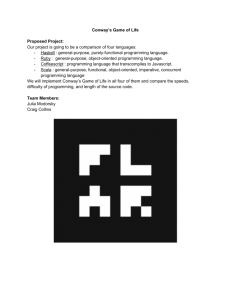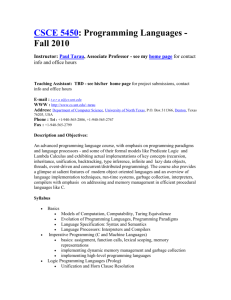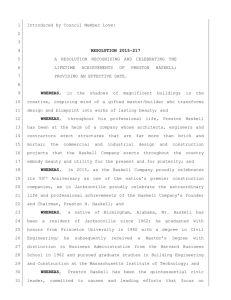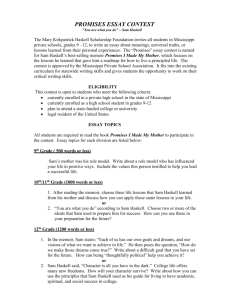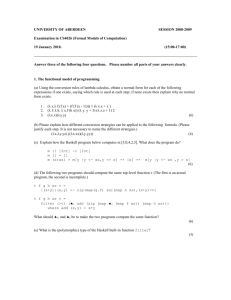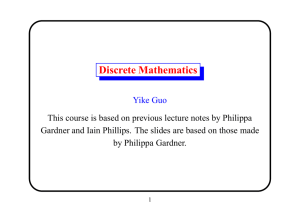Building .NET GUIs for Haskell applications
advertisement
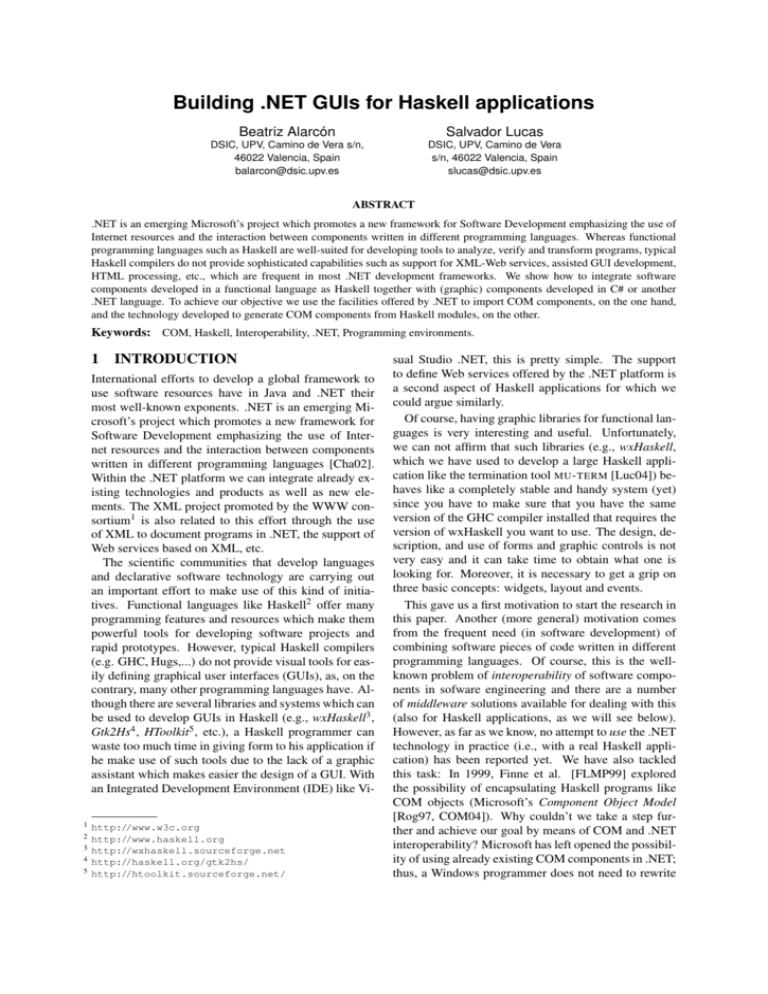
Building .NET GUIs for Haskell applications
Beatriz Alarcón
Salvador Lucas
DSIC, UPV, Camino de Vera s/n,
46022 Valencia, Spain
balarcon@dsic.upv.es
DSIC, UPV, Camino de Vera
s/n, 46022 Valencia, Spain
slucas@dsic.upv.es
ABSTRACT
.NET is an emerging Microsoft’s project which promotes a new framework for Software Development emphasizing the use of
Internet resources and the interaction between components written in different programming languages. Whereas functional
programming languages such as Haskell are well-suited for developing tools to analyze, verify and transform programs, typical
Haskell compilers do not provide sophisticated capabilities such as support for XML-Web services, assisted GUI development,
HTML processing, etc., which are frequent in most .NET development frameworks. We show how to integrate software
components developed in a functional language as Haskell together with (graphic) components developed in C# or another
.NET language. To achieve our objective we use the facilities offered by .NET to import COM components, on the one hand,
and the technology developed to generate COM components from Haskell modules, on the other.
Keywords: COM, Haskell, Interoperability, .NET, Programming environments.
1
INTRODUCTION
International efforts to develop a global framework to
use software resources have in Java and .NET their
most well-known exponents. .NET is an emerging Microsoft’s project which promotes a new framework for
Software Development emphasizing the use of Internet resources and the interaction between components
written in different programming languages [Cha02].
Within the .NET platform we can integrate already existing technologies and products as well as new elements. The XML project promoted by the WWW consortium1 is also related to this effort through the use
of XML to document programs in .NET, the support of
Web services based on XML, etc.
The scientific communities that develop languages
and declarative software technology are carrying out
an important effort to make use of this kind of initiatives. Functional languages like Haskell2 offer many
programming features and resources which make them
powerful tools for developing software projects and
rapid prototypes. However, typical Haskell compilers
(e.g. GHC, Hugs,...) do not provide visual tools for easily defining graphical user interfaces (GUIs), as, on the
contrary, many other programming languages have. Although there are several libraries and systems which can
be used to develop GUIs in Haskell (e.g., wxHaskell3 ,
Gtk2Hs4 , HToolkit5 , etc.), a Haskell programmer can
waste too much time in giving form to his application if
he make use of such tools due to the lack of a graphic
assistant which makes easier the design of a GUI. With
an Integrated Development Environment (IDE) like Vi1
2
3
4
5
http://www.w3c.org
http://www.haskell.org
http://wxhaskell.sourceforge.net
http://haskell.org/gtk2hs/
http://htoolkit.sourceforge.net/
sual Studio .NET, this is pretty simple. The support
to define Web services offered by the .NET platform is
a second aspect of Haskell applications for which we
could argue similarly.
Of course, having graphic libraries for functional languages is very interesting and useful. Unfortunately,
we can not affirm that such libraries (e.g., wxHaskell,
which we have used to develop a large Haskell application like the termination tool MU - TERM [Luc04]) behaves like a completely stable and handy system (yet)
since you have to make sure that you have the same
version of the GHC compiler installed that requires the
version of wxHaskell you want to use. The design, description, and use of forms and graphic controls is not
very easy and it can take time to obtain what one is
looking for. Moreover, it is necessary to get a grip on
three basic concepts: widgets, layout and events.
This gave us a first motivation to start the research in
this paper. Another (more general) motivation comes
from the frequent need (in software development) of
combining software pieces of code written in different
programming languages. Of course, this is the wellknown problem of interoperability of software components in sofware engineering and there are a number
of middleware solutions available for dealing with this
(also for Haskell applications, as we will see below).
However, as far as we know, no attempt to use the .NET
technology in practice (i.e., with a real Haskell application) has been reported yet. We have also tackled
this task: In 1999, Finne et al. [FLMP99] explored
the possibility of encapsulating Haskell programs like
COM objects (Microsoft’s Component Object Model
[Rog97, COM04]). Why couldn’t we take a step further and achieve our goal by means of COM and .NET
interoperability? Microsoft has left opened the possibility of using already existing COM components in .NET;
thus, a Windows programmer does not need to rewrite
all his applications to run them under .NET. In our case,
we show how to take advantage of this to pack Haskell
programs as software components and integrate them
into applications written in other languages, for example in C#, the most popular .NET language. Let’s give
a brief overview of our approach.
Our starting point is HaskellDirect (HDirect [Fin99,
FLMP99, HDi99]) a framework for Haskell FFI (Foreign Function Interface) based on the standard IDL (Interface Definition Language) which allows to specify a
programming interface in a programming language independent manner. There are many possibilities that
HDirect offer to the programmer: Creating Haskell
bindings to external libraries, creating external bindings
to Haskell libraries, creating Haskell client interfaces to
COM objects, and creating Haskell COM objects. In
our case, starting from a Haskell component, we build
a COM component which is encapsulated into a Dynamic Link Library (DLL), making it able to interoperate with Windows applications and, in particular with
.NET applications. Our particular interest is furnishing
Haskell applications with .NET GUIs, but most of the
discussion is completely general and independent from
this concrete goal. HDirect implements in Haskell all
the required functionality to build a COM component
and exempts the programmer from the knowledge of the
COM specification since it is generated automatically.
Next, we make use of the .NET facility to import COM
components which can be used as external functions to
implement the C# event handlers for the controls in the
.NET GUI.
The paper is organised as follows: Section 2 briefly
describes .NET graphic controls. Section 3 introduces a
simple case study which we use to illustrate our development. Section 4 explains how to build a COM component from a Haskell module. Section 5 addresses the
problem of its integration into .NET. Section 6 reports
on the results obtained on a concrete (realistic) application of our technique. Section 7 displays our conclusions and lines of future research.
2
OVERVIEW OF .NET GRAPHIC
CONTROLS
When a Windows programmer writes a .NET application (in, e.g., C#), he or she can take advantage of the
System.Windows.Forms namespace, which provides a
variety of control classes for developing rich user interfaces. Some controls are designed for data entry
in the application (e.g., TextBox and ComboBox controls). Other controls display application data (e.g.,
Label and ListView controls). The namespace also
provides controls for invoking commands within the
application, such as the Button and MainMenu controls. In this paper we are specially interested in showing how Haskell applications can take advantage from
.NET technology, specially from .NET GUIs. Thus,
we only consider the information (or data) that graphic
controls and Haskell components should (usually) exchange. Although other control properties (e.g., control labels, colors, etc.) could also be managed through
Haskell components, we will not consider them in detail here; we center the attention on the non-graphic part
of this information exchange . Extending the treatment
of controls to achieve such more generality would be
managed in a similar way, if necessary.
The hierarchy of .NET controls is very large. Here,
according to [FPB+ 03] we mention the most common
controls (which are also the most frequently used, in our
personal practice). We consider that these controls suffice for giving a complete account of the problems and
solutions that any other control could rise and require
to achieve our purpose.
The table in Figure 1 shows the Haskell-like data as
could be considered to be managed by each .NET control. This table shows that with few simple Haskell
datatypes can be managed all necessary information, regarding our main purpose of having the graphic part of
the application developed in .NET (C#) and the ‘logic’
of the program written in Haskell.
3
A SIMPLE CASE STUDY
In order to discuss the techniques developed here, we
use a simple case study. It includes a simple graphic
interface to introduce and manipulate strings by means
of simple transformations:
• converting the characters of the string into capital or
small letters,
• removing spare blank spaces, and
• simple encryption (based on the well-known Caesar’s method)
The length of each string is also stored (as an integer
value). In order to highlight the role of Haskell as the
language which actually implements the logic of the application, the use of C# here is strictly limited to provide
a GUI, i.e., to ease the introduction and visualization of
strings by means of graphic controls. The length of the
current string is displayed in a read only text control.
The different transformations are triggered by means
of buttons. The current string is selected from a ComboBox which shows the strings introduced so far (see
Figure 2).
In the Haskell part, we have the structures of functional data which are necessary to control the state of
the system: we store each pair string-length in a list
that is indexed by a integer that points out at the current
position of the list (Focus):
W INDOWS F ORMS
A SSOCIATED DATA
Button, GroupBox, Panel, Label, Splitter
CheckBox, RadioButton
ListBox
ComboBox
ListView
TrackBar, ProgressBar, NumericUpDown
TextBox, RichTextBox
MainMenu, OpenFileDialog, SaveFileDialog, FolderBrowserDialog
Bool
([Int],[String])
(Int,[String])
[[String]]
Int
String
-
Figure 1: .NET controls and data
languages) and connect them together. In the following, we show how to use COM technology to connect
Haskell with .NET components.
4.1
Figure 2: Simple example of interoperability
type Focus = Int
type Length = Int
data HL = H_L [(String, Length)]
Focus deriving Show
The algebraic data type HL contains all necessary information to implement the required functionality explained above. The following mappings manipulate this
data structure:
- Adds a new string and its length
addPair :: HL -> String -> HL
- Obtains the ‘current’ string
getString :: HL -> String
- Updates the ‘current’ string
writeString :: HL -> String -> HL
- Length of the ‘current’ string
getLength :: HL -> Int
- Sets the (index of)‘current’ string
setFocus :: HL -> Int -> HL
The following mappings implement the transformations over strings.
toUpperCase :: String -> String
toLowerCase :: String -> String
deleteB :: String -> String
encrypt :: String -> String
Haskell files and other (IDL, C#, etc.) archives as explained below can be retrieved from
http://www.dsic.upv.es/~balarcon/
example.zip.
4
INTEROPERABILITY BY MEANS
OF COM IN HASKELL
Microsoft’s COM technology is used to create re-usable
components (possibly written in different programming
Haskell modules and COM components
A Haskell program that implements a COM component
consists of four parts:
• The application code, written in Haskell by the programmer.
• An IDL specification establishing those Haskell
functions which we want to make accessible
through the DLL.
• A set of Haskell modules which are automatically
generated from the IDL by the HDirect tool.
• A Haskell library module, Com, that exports all the
functions needed to support COM objects in Haskell
and a C library module that provides some run-Time
support (RTS)
In the following sections we briefly describe and discuss these steps of the process.
4.2
The IDL of the Haskell component
IDL is a declarative language which is used to describe
interfaces and classes disregarding any programming
language [Hlu98]. An IDL specification describes the
interface of a component.
The IDL code in Figure 3 is used in our case study.
We have followed the example in [FLMP99], the indications of the manual of HDirect [Fin99] and the information about IDL [Hlu98]. We declare all (and only!)
Haskell functions that we wish to have accessible from
C# code together with their arguments and the type of
the returned value.
Now we are going to describe the IDL code. This is
useful to understand what we are going to obtain from
COM [Rog97, Ste04, COM04]. On the basis of the
IDL code, we are going to build the skeleton of the object that we want to encapsulate. For that purpose, we
have a library (Example), an interface (Iexample) and a class (EXAMPLE).
[ uuid(35E80A56-3664-4d91-9C6C-3018496A8D61) ,
helpstring("Haskell COM component") ,
version(1.0) ]
library Example {
importlib("stdole32.tlb");
[ object,
uuid(4DB0C045-CC9F-4607-B79A-26D27E0C1594)]
interface Iexample : IUnknown {
the method will be called (from C#). The attribute in
indicates that the parameter is used as an input given
to the method (e.g., in addPair), out indicates output
(e.g., in getString). The attribute string is used
with parameters that are pointers to characters. The
retval keyword indicates that the parameter must be
interpreted as the returned value of the function. It must
do it in this way, because the literal return of the method
is a HRESULT type, which is used to give back the information of errors.
HRESULT addPair([in,string]BSTR in);
HRESULT getString([out,retval] BSTR *out);
4.3
HRESULT
HRESULT
HRESULT
HRESULT
HRESULT
HRESULT
Once the IDL has been specified, the next step is to
generate the proxy and the skeleton of our component.
In order to generate those modules we use the following
(HDirect) command:
getLength([out,retval] int *out);
setFocus([in] int in);
toUpperCase();
toLowerCase();
deleteB();
encrypt();
Encapsulating a Haskell component
as a COM component
ihc -fcom example.idl -s -skeleton
};
This generates two Haskell files: EXAMPLE.hs and
ExampleProxy.hs. The first one contains the skeleton
of the methods that implement our component, that
is, the Haskell structure for the methods declared in
the IDL. The second one provides a proxy that adapts
our methods behind an interface COM to make the
communication possible.
[ object,
uuid(49D98D24-DC88-4d24-8C5D-404FE510644D)]
coclass EXAMPLE {
[default]interface Iexample;
};
};
Figure 3: IDL code for the case study
Regarding the definition of the skeleton, HDirect accomplishes three fundamental tasks:
A type library is a binary file that contains the same
information that we could find in a C or C++ header file.
It includes the names of the classes and the interfaces
which are implemented in the server and the number
and type of parameters for each method of their interfaces. Note that it also contains the GUID (Globally
Unique IDentifiers), a very important part of the model
of COM programming, for each class and interface. A
GUID is a structure of 128 bits “statistically guaranteed" to be unique. In our case we have used the tool
Create GUID (which is part of Visual Studio .NET) to
generate them.
A COM interface is a collection of linked methods
that perform a functionality. All are based on the IUnknown interface; each of them receives a unique interface identifier (IID).
A COM class is the implementation of one or more
COM interfaces, while a COM object is an instance
of a class. Each object has a class identifier (CLSID).
CLSID and IID are subgroup of GUID.
The name of our interface is Iexample and inherits from IUnknown the use of methods QueryInterface,
AddRef and Release. Inheritance from multiple interfaces is not allowed. The first attribute, object, which
is locked up in brackets next to the GUID, identifies
the interface as a COM interface. For each method
in the interface, we specify the parameters with which
• To import the necessary Haskell modules to give
support to the characteristics of the interface specified by the IDL.
• To introduce a State type to implement the (necessary) persistence of the functional data by means of
a mutable variable that can be initialized, read and
modified by means of the functions of the IOExts
library of GHC6 .
• To include Haskell declarations corresponding to the
functions defined in the IDL. Haskell functions will
have an additional argument corresponding to the
state of the application (that will be able to be read
or modified) and a monadic return type IO t where
t is the (non monadic) type returned as indicated in
the IDL (String or Integer, in our case).
The following step is to fill up the skeleton with the
Haskell code of our methods. In our case, the HList
module contains the methods in pure functional code,
so we will fill up the skeleton with the corresponding
calls to methods and the operations to read and write,
the state by means of readIORef and writeIORef
(defined in IOExts). For instance, for deleteB, we
have:
6
Glasgow Haskell Compiler, http://www.haskell.org/ghc.
HKEY_CLASSES_ROOT. Under it, we can find all
the CLSIDs of the components installed in the system.
A CLSID is contained in the registry as an alphanumeric string with the following format: {xxxxxxxxxxxx-xxxx-xxxx-xxxxxxxxxxxx}.
module EXAMPLE where (...)
import IOExts
-Pure Haskell Component
import qualified Hlist
data State = State(IORef HList.HL)
.
.
.
deleteB :: State
-> Prelude.IO ()
deleteB (State st) = do
hl <- readIORef st
;str’ <- Prelude.return
(HList.deleteB (HList.getString hl))
; writeIORef st(HList.writeString str’ hl)
4.4
5.1
A .NET client cannot directly communicate with a
COM component because the interfaces exposed by
the COM component cannot be read from the .NET
application. The data types, the mechanisms for
managing errors, etc., are different for managed and
unmanaged objects8 . In order to simplify the interoperation between the components of .NET Framework and
the unmanaged code, the CLR (Common Language
Runtime) hides the differences between them both to
clients and servers. This is achieved by means of a
RCW (Runtime Callable Wrapper)(to understand the
whole process see Figure 4) . The .NET SDK provides
RCW to obtain it, thus a .NET application can see the
unmanaged component as if it was managed. In .NET
there are several ways to do this:
Creating a COM DLL from Haskell
modules
The next step is to compile the two new files to generate
the .hi and .o files and the stubs of the proxy:
ghc -c EXAMPLE.hs
Using COM components in .NET applications
ExampleProxy.hs
Now we have to decide how to encapsulate our component. HDirect provides solutions to build servers of
internal processes (DLLs) or servers of external processes (EXEs). We have chosen to implement a DLL.
Although it entails a bit more effort, the user benefits
from a simpler use of the COM model, as the COM
object is loaded without any intervention from the user.
In order to implement a DLL, the next step is to include the ComDllMain.lhs and dll_stub.c modules in
the directory and compile them. Finally it is necessary to provide a Main module (required by GHC for
descriptive purposes).
Once the module Main has been compiled, we build
the type library (.tlb) using HDirect from the IDL and
the proxy, generating example.tlb:
• Using the Type Library Importer utility (Tlbimp.exe), provided together with the .NET
Framework.
• Making reference to the COM component directly
from the C# application.
Tlbimp is a console application that converts the type
definitions found in a COM type library into equivalent
definitions in a .NET assembly. The assembly produced
by the Tlbimp.exe tool is a standard .NET assembly that
can be examined with Ildasm.exe (MSIL disassembler).
ihc -s -fanon-typelib -v -c example.idl -o
ExampleProxy.hs -output-tlb=example.tlb
The type library is a resource that we must bind to our
DLL. Resources are specified using a special and very
simple text file, called resource script or .rc file. The
file contains the specification of the resources that we
want to include in the program or DLL (in our case the
type library) for compiling it with the resource compiler. The resource compiler converts the file .rc into an
object file (.o). The resource compiler is a GNU binary
utility called windres. We use it along with cygwin to
include example.tlb in our project. Now, we can build
the DLL.
5
INTEGRATION OF COM INTO .NET
At this point, we must insert the COM DLL into our
Visual Studio.NET project7 . Having the DLL, it is
necessary to register the generated component. The
simplest way is using regsvr32.exe, in the commandprompt window. COM only uses a registry branch:
Figure 4: Interoperability with .NET from Haskell
After registering our DLL, we use Tlbimp and we run
VS.NET. From our Windows application we click the
8
7
We use Visual Studio.NET 2003.
The .NET native CLR code is called ‘managed’, in contrast to any
other machine-dependent code which is ‘unmanaged’ [Cha02].
On the other hand, the C# part of the .NET version of
(consisting of six new modules with about
2000 lines altogether, most of them generated automatically(!) by the graphic assistant) includes a new C#
module WinMuTermNET.cs that implements the creation of the new user interface and manages the events
transforming them in function calls to Haskell code by
means of exchanges of strings and integers. This C#
component uses the COM DLL generated from WinMuTermNET.hs (together with the other Haskell modules). The .NET version of MU - TERM is available on
the MU - TERM WWW site.
right button on the References file in the VS Solution
Explorer, we select Add reference and look for the assembly which we have just generated. Now it can be
used exactly as any other .NET assembly: we just create an instance (denoted by h) of the appropriate class:
MU - TERM
ExampleClass h = new ExampleClass();
Now we can access to Haskell functions as if they
were C# functions (see Figure 5).
7
We have shown how to integrate software components
developed in Haskell together with (graphic) components developed in C#, or other .NET language. Our
starting point is HDirect which permits to build a COM
component from a Haskell module, and making it available as a COM DLL which can interoperate with .NET
applications. We have shown the practicality of this approach by giving a new .NET GUI to a Haskell tool like
MU - TERM . Other remarkable aspects are:
Figure 5: Haskell functions in C#
We can use them to program the event handlers on
the GUI that we have developed.
6
A .NET VERSION OF MU-TERM
MU - TERM is a termination proof tool for (ContextSensitive) Rewriting Systems.
(Context-sensitive)
Rewrite Systems are useful for describing semantic aspects of a number of programming languages
(e.g., Maude, OBJ2, OBJ3, or CafeOBJ) and
analyzing the computational properties of the corresponding programs, in particular termination (see
[DLM+ 04, Luc01, Luc02]). The tool implements the
generation of the appropriate orderings and transformations for proving termination. MU - TERM is written
in Haskell and wxHaskell was used to develop the
graphical user interface. The system consists of around
30 Haskell modules containing more than 5000 lines
of code. We refer the reader to [Luc04] for more
information about the use and functionality of the tool.
Compiled versions and instructions for the installation
are available on the MU - TERM WWW site.
We have developed a new (hybrid) version of
MU - TERM which, having the same functionalities
(implemented by the same Haskell modules), includes
a GUI written in C# which replaces the old one. Let’s
take a look to the windows which constitute the GUI
of MU - TERM (see Figures 6 and 7) and let’s consider
the corresponding controls.
As it can be noticed,
the controls to manage in the interface are MenuFile,
Button, ComboBox, CheckBox, TextBox, ListBox, etc.
In Section 2 we discussed them and their associated
data. We have applied the process described in Sections
4 to 5 to MU - TERM and the obtained results were very
satisfactory. The new version of MU - TERM is now
composed of the same number of Haskell modules but
the WinMuTerm.hs module, which contained about
1200 lines of code, has been replaced by a new module
WinMuTermNET.hs, that contains less than 800 lines.
CONCLUSIONS AND FUTURE
WORK
• it is a complete experience of ’weak’ integration
of software components written in a functional language like Haskell in a software development platform like .NET that still does not manage the inclusion of sources written directly in this language.
• it is a pioneer experience in the functional programming community, since MU - TERM is the first complex software written in Haskell that uses COM
technology by means of HDirect.
• it is also a pioneer experience for the academic community interested in the interoperability of program
analysis software tools, specially regarding tools for
proving termination, where interoperability of different tools can be important 9 .
In the world of functional languages, there are
more or less complete approximations to .NET for
the languages10 . Regarding Haskell, a full-featured
Haskell development environment has been recently
implemented. It is called Visual Haskell [AM05]. Although it is an interesting contribution for the Haskell
community, it does not treat the possibility of building
graphic user interfaces for Haskell programs using
the .NET resources. In their project they have also
used HDirect, although they did not find it completely
9
See,
for
instance,
http://www.lri.fr/~marche/
termination-competition.
10ML http://www.cl.cam.ac.uk/Research/TSG/SMLNET
or Mondrian http://www.mondrian-script.org.
Figure 6: Principal window of MU - TERM
Figure 7: Rest of MU - TERM windows
appropriate for their purposes. This is also in contrast
to ours: due to the simplicity of the information
exchange between the C#-based user GUI and the core
Haskell application, we find HDirect to be easy to use
(although it took time to reach a sufficient know-how).
For instance, HDirect limits the structures of Haskell
data that are directly interchangeable by means of
COM to strings and integers (of 32 bits). This can be a
problem for most applications, but it is not problematic
for developing GUIs, since the involved data types (see
Section 2) are easily exchangeable in such format.
These initiatives to integrate functional languages
into the .NET framework reveal the interest of the
community to converge to this platform. Our experience is also encouraging. We plan to develop the
theoretical aspects of our work, and also envisage
possible extensions of this experience to other tools
and programming languages in the future. In particular,
we want to explore the use of the .NET facilities for
using Web Services based on XML with these tools
and programming languages. A first candidate, again,
could be the termination tool MU - TERM.
ACKNOWLEDGEMENTS
Work partially supported by Spanish MEC grant SELF
TIN 2004-07943-C04-02, Acción Integrada HU 20030003, and EU-India Cross-Cultural Dissemination
project ALA/95/23/2003/077-054.
REFERENCES
[AM05]
K. Angelov and S. Marlow. Visual Haskell. In Proc.
of Haskell Workshop, Haskell’05, pages 5-16, ACM
Press, 2005.
[Arc01]
T. Archer. Inside C#. McGraw-Hill, 2001.
[Cha02]
D. Chappell. Understanding .NET. Addison Wesley,
2002.
[COM04]
COM, Component Object Model. http://www.
etse.urv.es/EngInf/assig/ens4/2004/
net4a.pdf
[DLM+ 04]
F. Durán, S. Lucas, J. Meseguer, C. Marché, and X.
Urbain. Proving Termination of Membership Equational Programs. In P. Sestoft and N. Heintze, editors,
Proc. of ACM SIGPLAN 2004 Symposium on Partial
Evaluation and Program Manipulation, PEPM’04,
pages 147-158, ACM Press, New York, 2004.
[Fin99]
S. Finne. HaskellDirect User«s Manual. November, 1999.
[FLMP99]
S. Finne, D. Leijen, E.Meijer, S. Peyton Jones. Calling hell from heaven and heaven from hell. In Proc.
of 4th ACM SIGPLAN International Conference on
Functional Programming, ICFP’99, Sigplan Notices
34(9):114-125, 1999.
[FPB+ 03]
J. Ferguson, B. Patterson, J. Beres, P. Boutquin, and
M. Gupta. C#’s bible. Microsoft Press, 2003.
[HDi99]
H/Direct: supporting component programming
in Haskell.
http://www.haskell.org/
hdirect/design.html#toc3
[Hlu98]
B. Hludzinski. Understanding Interface Definition Language: A Developers Survival Guide,
1998.
http://www.microsoft.com/msj/
0898/idl/idl.htm
[Hoa03]
T. Hoare. The Verifying Compiler: A Grand Challenge for Computing Research. Journal of the ACM,
50(1):63-69, 2003.
[Luc01]
S. Lucas. Termination of Rewriting With Strategy
Annotations. In Proc. of LPAR’01, LNAI 2250:669684, Springer-Verlag, Berlin, 2001.
[Luc02]
S. Lucas. Context-sensitive rewriting strategies. Information and Computation, 178(1):293-343, 2002.
[Luc04]
S. Lucas. MU-TERM: A Tool for Proving Termination of Context-Sensitive Rewriting In V. van Oostrom, editor, Proc. of 15h International Conference
on Rewriting Techniques and Applications, RTA’04,
LNCS 3091:200-209, Springer-Verlag, Berlin,
2004. Available at http://www.dsic.upv.es/
~slucas/csr/termination/muterm.
[Rog97]
D. Rogerson. Inside COM. Microsoft’s Component
Object Model. Microsoft Press, 1997.
[Ste04]
P. Steele. 15 Seconds: COM Interop Exposed.
2004. http://www.15seconds.com/issue/
040721.htm
[Tro02]
A. Troelsen.
Apress, 2002.
COM and .NET Interoperability.



